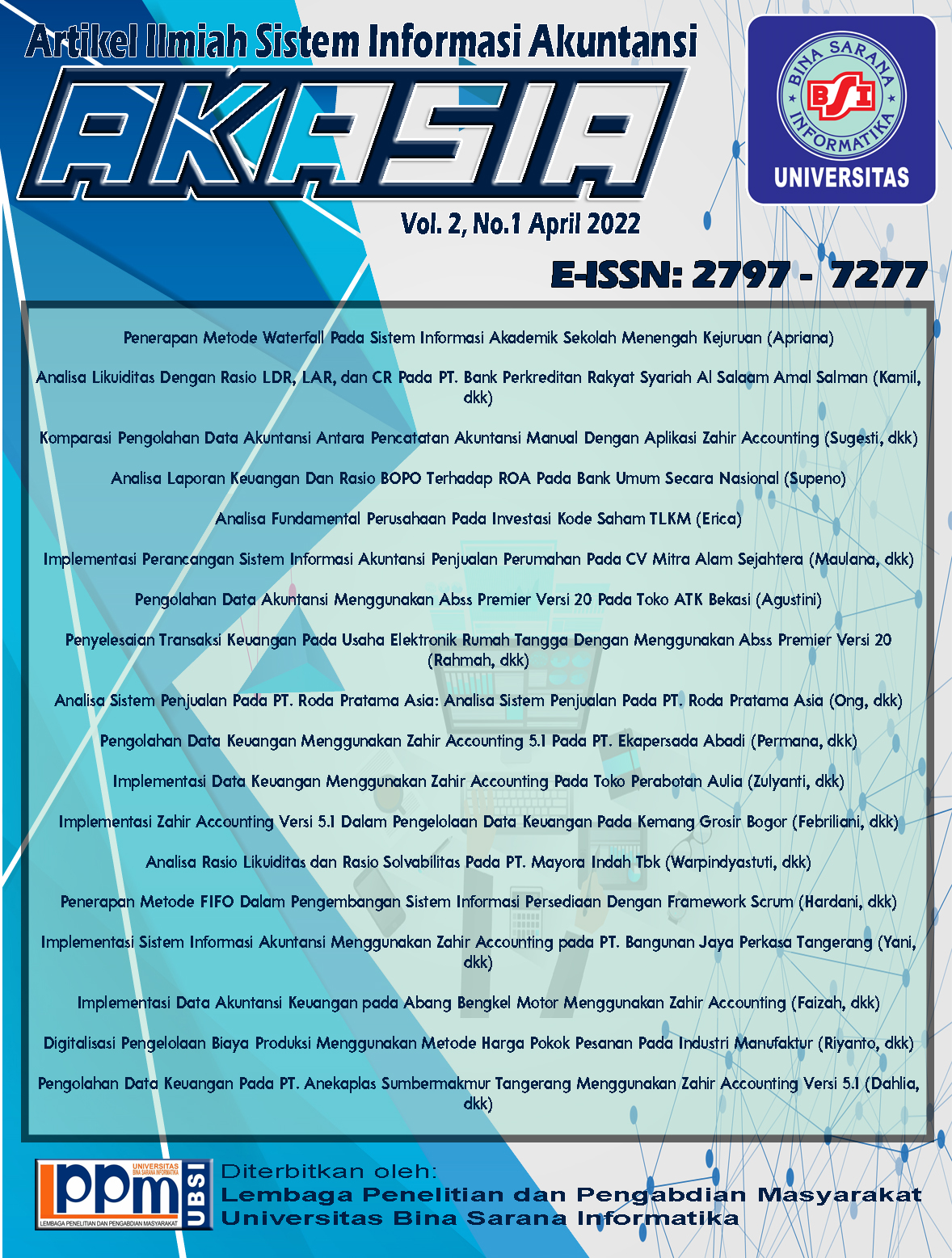Analisa Laporan Keuangan Dan Rasio BOPO Terhadap ROA Pada Bank Umum Secara Nasional
DOI:
https://doi.org/10.31294/akasia.v2i1.1076Keywords:
Profitability Performance , BOPO Rations, ROA RationsAbstract
Abstract- Commercial banks are financial institutions whose business objectives are to earn profits so that banks can continue to grow healthily. The ability to earn profits from a bank is determined by the achievement of business results during a period that can be analyzed through profit statement. In the income statement can be known how much net interest income, other non-interest operating income, other non-interest operating expenses, and non-operating income so that in the end can be known pre-tax income. To obtain maximum profit, there is a need for efficiency of elements in the group of operating expenses and operating income by using the BOPO ratio indicator. The smaller the BOPO ratio, the more efficient the bank is and has the ability to obtain profits calculated by the Return on Asset (ROA) ratio indicator. This study raises issues related to the development of profit loss performance conditions, BOPO ratio and ROA ratio in conventional commercial banks nationally in the third quarter of 2019, 2020, and 2021. The method used is qualitative descriptive with a clustered analysis data from Indonesian banking statistics accessed from the Financial Services Authority website. The results showed that the performance conditions of conventional commercial banks nationally during economic pressures as a result of the pandemic crisis in 2020 and 2021 are still in good condition and experiencing growth despite slowing.
Keywords: Financial Statements, BOPO Ratios, ROA Ratios
References
Fathony, A., & Julianti, L. (2020). Pengaruh Dana Pihak Ketiga Dan Simpanan Dari Bank Lain Terhadap penyaluran Kredit. Jurnal Akurat, 11(Mei-Agustus), 76–90.
https://unibba.ac.id/ejournal/index.php/akurat/article/download/317/275
Hertinsyana, D. (2019). Perbedaan Kinerja Bank Umum (Studi di Bank Umum Pemerintah dan Swasta Nasional). Journal of Business Economics, 24(2), 181–192. https://doi.org/10.35760/eb.2019.v24i2.1908
Kasmir. (2012). Bank Dan Lembaga Keuangan Lainnya. Jakarta: PT Raja Grafindo Persada.
Marwansyah, S., & Setyaningsih, E. D. (2018). Pengaruh Kinerja Perbankan Terhadap Rasio Profitabilitas Pada Bank BUMN. Jurnal Riset Akuntansi Jambi, 6(1), 11–18. https://doi.org/10.35141/jraj.v1i1.375
Maulana, P., Dwita, S., & Helmayunita, N. (2021). Pengaruh CAR, NPL, LDR dan BOPO Terhadap Return ON Assets (ROA) pada Bank yang Terdaftar di Bursa Efek Indonesia Tahun 2017-2019. Jurnal Eksplorasi Akuntansi, 3(2), 316–328. https://doi.org/10.24036/jea.v3i2.355
Panjaitan, S. O., & Fauziah, S. (2021). Implementasi Data Keuangan Menggunakan Zahir Pada. 1(April), 16–22.
http://jurnal.bsi.ac.id/index.php/akasia/article/view/409/251
Prasanti, D. (2018). Model - Model Penelitian Tindakan Kelas. Jurnal Ilmu Komunikasi, 6(1), 13–21.
https://e-jurnal.lppmunsera.org/index.php/LONTAR/article/download/645/634
Setiawan, A. (2021). Analisis Laporan Keuangan Pada PT BNI (Persero) TBK. Jurnal Riset Akuntansi, 13(2), 101–110.
https://ojs.unikom.ac.id/index.php/jira/article/view/4153
Suciaty, A., Haming, M., & Alam, N. (2019). Pengaruh CAR, BOPO, NPL dan LDR Terhadap ROA pada Bank BUMN Yang Terdaftar di Bursa Efek Indonesia. Center Of Economic Student Journal, 2(3), 57–74. https://jurnal.fe.umi.ac.id/index.php/CESJ/article/view/303
Supeno, W. (2019). Analisis Efisiensi BOPO terhadap Laba Bersih pada BPR. Jurnal Kajian Ilmiah, 19(2), 182–194. https://jurnal.ubharajaya.ac.id/index.php/kajian-ilmiah/article/view/460/pdf
Supeno, W., & Islami, V. (2019). Evaluasi Penerapan Tata Kelola Bank Pada PT BPR Eka Bumi Artha. Moneter - Jurnal Akuntansi Dan Keuangan, 6(2), 157–166. https://doi.org/10.31294/moneter.v6i2.6439








